February 11th, 2020
Let’s be honest, seeing a one or two year old sucking their thumb is kind of cute. It makes you want to pick up the baby and give it a big hug and a kiss. However, thumbsucking is not limited to infants and toddlers.

As an orthodontist, I have had patients as old as 50+ who are thumb suckers. These patients relate to me that the thumbsucking is soothing and just helps them relax, especially when it is time to fall asleep. I have no problem with thumbsucking in regard to the social and emotional benefits it provides to some patients. We all have different ways of relaxing and easing the stresses of daily life. Who am I to judge?
The problem with thumbsucking from an orthodontic perspective lies in its effect on the movement of the teeth and the growth of the jaws. Prolonged thumbsucking over months and years will guarantee the need for braces and probably an expander in the future. The suction your mouth creates as you suck your thumb pushes your cheeks against your upper back teeth and splays your upper front teeth forward and your lower front teeth backward. The classic thumb sucker has a narrow palate with a crossbite on both sides and their front teeth stick out and don’t touch. The longer the thumbsucking goes on, the more exaggerated are the effects - especially once the permanent teeth start to grow in.
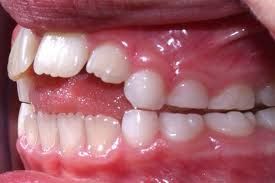
With my own children, I encourage the use of a pacifier to help the babies fall asleep and then when my kids have turned two, the “binky” fairy comes and takes away their binky to give it to another deserving child and leaves an exciting toy to replace it. They struggle for a few nights and then usually settle in without missing a beat. Thumbs are a lot harder to get rid of.
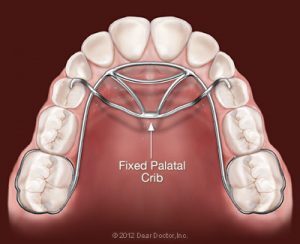
Treatments are available to help with the cessation of thumbsucking. I will usually recommend a product called Mavala (purchased on Amazon) as a first line of defense and then a habit appliance for patients who continue to struggle. If you need help easing your child away from their thumbsucking habit, or if you yourself have desires to move on from thumbsucking, please contact our office. Your orthodontist can definitely be a huge help in avoiding more serious orthodontic problems down the road.
November 22nd, 2019
So your orthodontist said your child needs a palatal expander? Here is some helpful information to become familiar with what to expect moving forward.
How does it work?
Palatal expanders are a commonly used appliance in orthodontics to make room for crowded teeth, correct crossbites, increase the size of the airway and/or widen a narrow upper jaw. Many of us have held a newborn baby and felt the “soft spots” on their tender little heads. Those “soft spots” are cartilage sutures that have not yet closed in their developing skulls. In much the same way, each of us has a cartilage suture in our upper jaw that splits the upper jaw into two halves. At the onset of puberty, that suture starts to fuse together into one bone. However, prior to the fusion of the bone the upper jaw can be expanded significantly using a palatal expander. As the palate expands, the cartilage is stretched and stimulates bone to fill into the space created by the expander. If given enough time to stabilize, the jaw will then fill in with bone at the new “corrected” width. Pretty amazing!
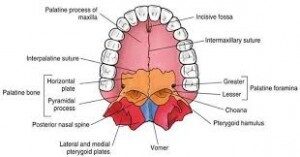
Interestingly, the lower jaw does not have a suture to match the upper jaw, which limits the amount of expansion you can achieve on your bottom teeth.
What does it look like?
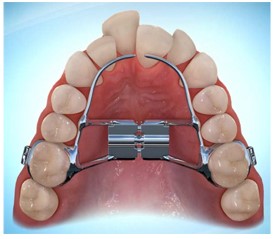
The expander connects to your top molar teeth with little metal rings called “bands”. Wires connected to these bands rest gently on the teeth. There is an activating mechanism in the center of the expander that can easily be turned with a “key” that is given to each patient. Your orthodontist will show you how to use the key – it is really easy! The key will slowly and gently widen the jaw with each activation about 0.25 mm. In our office, one activation is recommended each night before bedtime. Over the course of each 4 day period, the jaw widens just 1 millimeter. While this may not seem like much, within just a few weeks you will have created much more space for the teeth to fit into. You may experience some slight discomfort as the suture starts to open, but this process is relatively pain-free.
As the suture opens, you will often see a space open up between the two front teeth. This is normal and is evidence that the expander is doing its job. After your expansion is complete, the space will naturally start to close as the crowded teeth unravel. Any residual space will be closed with your braces.
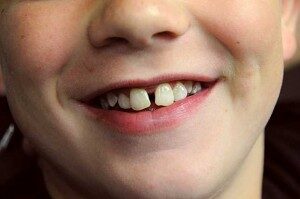
How do you maintain the expander?
Keeping your teeth healthy while going through treatment with a palatal expander is pretty easy – it just takes a little extra time and effort when you are brushing and flossing your teeth. Your orthodontist will likely give you some extra little brushes to help you clean well around your expander and show some spots that are commonly missed. A Waterpik or similar device is also a helpful tool to clean around the expander. You should brush your expander the same way you would brush your teeth - until it looks clean and shiny with no white “fuzzies” (plaque) sitting on it.
Before you know it, you will have the stunning smile you have always wanted. Good luck! If you have any questions regarding expanders or orthodontic treatment, give our office a call.













 Website Powered by Sesame 24-7™
Website Powered by Sesame 24-7™